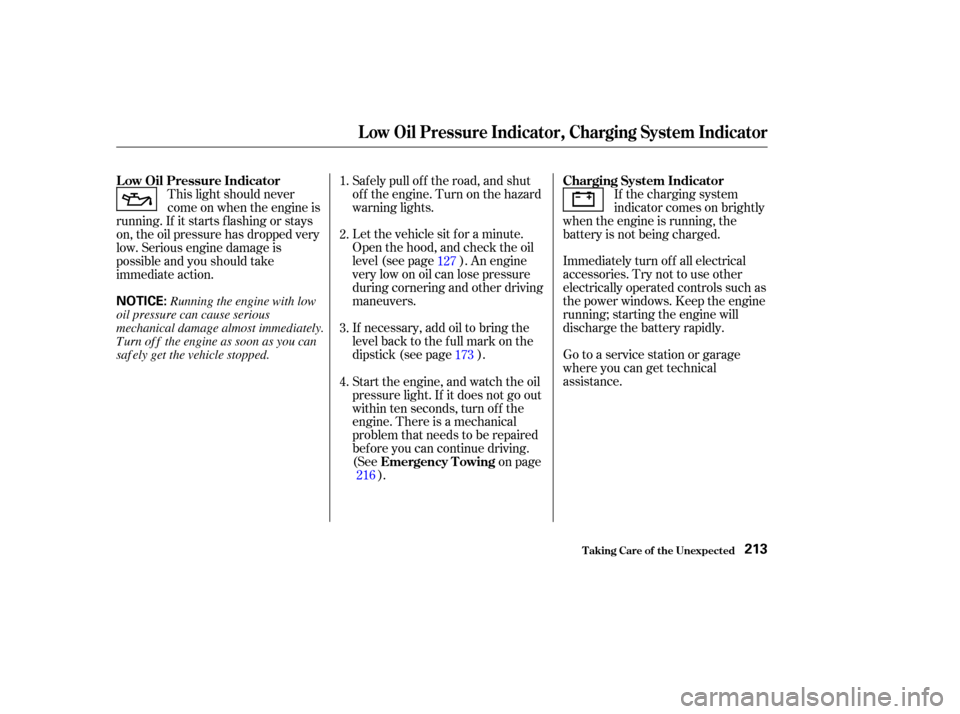Page 217 of 256

Let the vehicle sit f or a minute.
Open the hood, and check the oil
level (see page ). An engine
very low on oil can lose pressure
during cornering and other driving
maneuvers.
If necessary, add oil to bring the
level back to the full mark on the
dipstick (see page ).If the charging system
indicator comes on brightly
when the engine is running, the
battery is not being charged.
Immediately turn of f all electrical
accessories. Try not to use other
electrically operated controls such as
the power windows. Keep the engine
running; starting the engine will
discharge the battery rapidly.
Go to a service station or garage
where you can get technical
assistance.
This light should never
come on when the engine is
running. If it starts f lashing or stays
on, the oil pressure has dropped very
low. Serious engine damage is
possible and you should take
immediate action. Saf ely pull of f the road, and shut
of f the engine. Turn on the hazard
warning lights.
Start the engine, and watch the oil
pressure light. If it does not go out
within ten seconds, turn off the
engine. There is a mechanical
problem that needs to be repaired
bef ore you can continue driving.
(See
on page
).
1.
2.
4. 3.
173
216 127
L ow Oil Pressure Indicator
Emergency T owingCharging System Indicator
L ow Oil Pressure Indicator, Charging System Indicator
T aking Care of t he Unexpect ed213
NOTICE:
Running the engine with low
oil pressure can cause serious
mechanical damage almost immediately.
Turn of f the engine as soon as you can
saf ely get the vehicle stopped.
Page 218 of 256

To check if they are set, turn the
ignition to ON (II), without starting
the engine. The Malf unction
Indicator Lamp will come on f or 20
seconds. If it then goes of f , the
readiness codes are set. If it blinks 5
times, the readiness codes are not
set. If possible, do not take your
vehicle f or a state emissions test
until the readiness codes are set.
Refer to State Emissions Testing for
more inf ormation, on page .
If the indicator comes on
while driving, it means one
of the engine’s emission control
systems may have a problem. Even
though you may f eel no dif f erence in
your vehicle’s perf ormance, it can
reduce your f uel economy and cause
increased emissions. Continued
operation may cause serious damage.
If you have recently ref ueled your
vehicle, the indicator coming on
could be a loose or missing f uel f ill
cap. Tighten the cap until it clicks at
least three times. Tightening the cap
will not turn the indicator turn of f
immediately; it takes at least three
days of normal driving. If the indicator comes on repeatedly,
even though it may turn of f as you
continue driving, have the vehicle
checked by the dealer as soon as
possible.
Your vehicle has certain ‘‘readiness
codes’’ that are part of the on-board
diagnostics f or the emissions
systems. In some states, part of the
emissions testing is to make sure
these codes are set. If they are not
set, the test cannot be completed.If your vehicle battery has been
disconnected or gone dead, these
codes are erased. It takes at least
three days of driving under various
conditions to set the codes again.
234
T aking Care of t he Unexpect ed
Readiness Codes
Malf unction Indicator L amp
214
NOTICE:If you keep driving with the
Malf unction Indicator Lamp on, you
can damage your vehicle’s emission
controls and the engine. Those repairs
may not be covered by your vehicle’s
warranties.
Page 222 of 256
Turn the ignition switch to LOCK
(0). Make sure the headlights and
all other accessories are off.
Remove the cover f rom the f use
box.
If something electrical in your
vehicle stops working, check f or a
blown f use f irst. Determine f rom the
chart on pages and or the
diagram on the f use box lid, which
f use or f uses control that device.
Check those f uses f irst, but check all
the f uses bef ore deciding that a
blown f use is the cause. Replace any
blown f uses and check if the device
works.
The interior f use box is underneath
the steering column. To remove the
f use box lid, pull it toward you and
take the lid out of its hinges. The vehicle’s f uses are located in
two f use boxes. The under-hood f use
box is located in the engine
compartment on the driver’s side. To
open it, push the tabs as shown.1.
2.221 222
Checking and Replacing Fuses
Fuses
T aking Care of t he Unexpect ed218
TAB
INTERIOR
UNDER-HOOD
Page 228 of 256
Your vehicle has several identif ying
numbers located in various places.
The Vehicle Identif ication Number
(VIN) is the 17-digit number your
Honda dealer uses to register your
vehicle f or warranty purposes. It is
also necessary f or licensing and
insuring your vehicle. The easiest
placetofindtheVINisonaplate
fastened to the top of the dashboard.
Youcanseeitbylookingthrough
the windshield on the driver’s side. It
is also on the Certification label at-
tached to the driver’s doorjamb, and
is stamped on the engine com-
partment bulkhead. The VIN is also
provided in bar code on the
Certif ication label.
Identif ication Numbers
T echnical Inf ormation224
VEHICLE IDENTIFICATION NUMBERCERTIFICATION LABEL
Page 229 of 256
The Engine Number is stamped into
the engine block.
The Transmission Number is on a
label on top of the transmission.
Identif ication Numbers
T echnical Inf ormation225
AUTOMATIC TRANSMISSION NUMBER
ENGINE NUMBER MANUAL TRANSMISSION NUMBER
Page 230 of 256

�Î�Î
�Î
�Î
�Î
�Î
�Î
Specif ications
T echnical Inf ormation226
Capacities Engine Weights Dimensions
178.6 in (4,537 mm) 1.43 US gal (5.4
)
1.88 US gal (7.1)
1.45 US gal (5.5
)
1.90 US gal (7.2)
3.3 US qt (3.1
)
3.1 US qt (2.9)
7.6 US qt (7.2
)
6.9 US qt (6.5)
2.0 US qt (1.9)
2.4 US qt (2.3)
1.1 US qt (1.0
)
1.3 US qt (1.2)
4.8 US qt (4.5
)
2.6 US qt (2.5)
0.16 US gal (0.6
)
Engine
coolant
Automatic
transmission
fluid
Manual
transmission
fluid
Rear
differential
fluid (4WD)
Windshield
washer
reservoir
Excluding the oil remaining in the engine.
Including the coolant in the reserve tank and that remaining in the
engine.
Reserve tank capacity:
Fuel tank
Engine oil
5.6 US qt (5.3
)
4.2 US qt (4.0)
4.4 US qt (4.2)
15.3 US gal (58
)
Type
BorexStroke
Displacement
Compression ratio
Spark plugs Gross vehicle weight rating Length
Width
Height
Wheelbase
Track
See the certification label attached
to the driver’s doorjamb.
SKJ20DR-M11 IZFR6K-11 9.6 : 1
144 cu-in (2,354 cm
)
3.43 x 3.90 in (87.0 x 99.0 mm) Water cooled 4-stroke DOHC
VTEC 4-cylinder gasoline engine 60.6 in (1,538 mm)
60.4 in (1,533 mm)
103.1 in (2,620 mm)
66.2 in (1,682 mm)
70.2 in (1,782 mm)
179.1 in (4,550 mm)
Approx.
Front
Rear
Change
Without filter
Total 1:
2:Change
Total
Change
Total
Change
4WD
2WD
Total 4WD
2WD
Change
Total
Change
Total
U.S. Vehicles
Canada
Vehicles
(NGK)
(DENSO)
1 : Canada EX-L model
4WD
Automatic Transmission
Manual Transmission
1 2
2
1
Including filter
Page 235 of 256

�Î
�ÎThe United States Clean Air Act
sets standards f or automobile
emissions. It also requires that
automobile manufacturers explain to
owners how their emissions controls
workandwhattodotomaintain
them. This section summarizes how
the emissions controls work.
Scheduled maintenance is on page .
The burning of gasoline in your
vehicle’s engine produces several by-
products. Some of these are carbon
monoxide (CO), oxides of nitrogen
(NOx) and hydrocarbons (HC).
Gasoline evaporating f rom the tank
also produces hydrocarbons. Con-
trolling the production of NOx, CO,
and HC is important to the environ-
ment. Under certain conditions of
sunlight and climate, NOx and HC
react to f orm photochemical ‘‘smog.’’
Carbon monoxide does not contri-
bute to smog creation, but it is a
poisonous gas.
In Canada, Honda vehicles comply
with the Canadian Motor Vehicle
Saf ety Standards (CMVSS) f or
Emissions valid at the time they are
manuf actured.
Your vehicle has a Positive
Crankcase Ventilation System. This
keeps gasses that build up in the
engine’s crankcase f rom going into
the atmosphere. The Positive Crank-
case Ventilation valve routes them from the crankcase back to the
intake manif old. They are then
drawn into the engine and burned.
As gasoline evaporates in the f uel
tank, an evaporative emissions
control canister f illed with charcoal
adsorbs the vapor. It is stored in this
canister while the engine is of f . Af ter
the engine is started and warmed up,
the vapor is drawn into the engine
and burned during driving.
The Onboard Ref ueling Vapor
Recovery (ORVR) system captures
the f uel vapors during ref ueling. The
vapors are adsorbed in a canister
f illed with activated carbon. While
driving, the f uel vapors are drawn
into the engine and burned of f .
168
The Clean Air Act
Crankcase Emissions Control
System Evaporative Emissions Control
System
Onboard Ref ueling Vapor
Recovery
Emissions Cont rols
T echnical Inf ormation231
Page 236 of 256

The PGM-FI System uses sequential
multiport f uel injection.
It has three subsystems: Air Intake,
Engine Control, and Fuel Control.
The Engine Control Module (ECM)
or the Powertrain Control Module
(PCM) uses various sensors to
determine how much air is going
into the engine. It then controls how
much f uel to inject under all operat-
ing conditions.
This system constantly adjusts the
ignition timing, reducing the amount
of HC, CO, and NOx produced.
The three way catalytic converter is
in the exhaust system. Through
chemical reactions, it converts HC,
CO, and NOx in the engine’s exhaust
to carbon dioxide (CO ), dinitrogen
(N ), and water vapor.The emissions control systems are
designed and certif ied to work to-
gether in reducing emissions to
levels that comply with the Clean Air
Act. To make sure the emissions
remain low, you should use only new
Honda replacement parts or their
equivalent f or repairs. Using lower
qualitypartsmayincreasethe
emissions f rom your vehicle.
The exhaust emissions controls
include three systems: PGM-FI,
Ignition Timing Control, and Three
Way Catalytic Converter. These
three systems work together to
control the engine’s combustion and
minimize the amount of HC, CO, and
NOx that comes out the tailpipe. The
exhaust emissions control systems
are separate from the crankcase and
evaporative emissions control
systems.
The emissions control systems are
covered by warranties separate from
the rest of your vehicle. Read your
warranty manual f or more informa-
tion.
2
2
Exhaust Emissions Controls Replacement PartsPGM-FI Syst em
Ignit ion T iming Cont rol Syst emThree Way Catalytic Converter
Emissions Cont rols
T echnical Inf ormation232